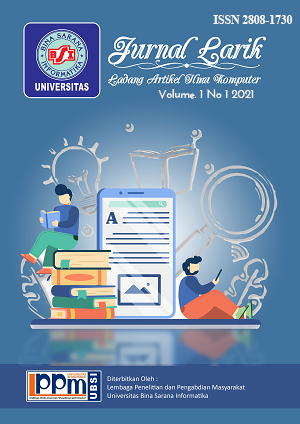S, Sis Sistem Penunjang Keputusan Pemilihan Karyawan Terbaik di Restoran Soto Pak J Menggunakan Metode AHP
Sistem Penunjang Keputusan
DOI:
https://doi.org/10.31294/larik.v1i1.504Keywords:
Sistem Pendukung Keputusan (SPK), Analytical Hierarchy Process (AHP), Karyawan, Restoran, AHP, KaryawanAbstract
Abstract - Restaurant leaders need an employee who can be trusted to serve guests or visitors who come to the restaurant well. Selection of the best employees is an important aspect of performance management because it produces useful information for employee administrative decisions such as promotions or training and other decisions. The best employee performance is not only selecting and assigning the right employees but it is also important for leaders to plan carefully in motivating and developing employees. So it is necessary to make a Decision Support System (DSS) by applying the Analytical Hierarchy Process (AHP) method. AHP method is a method for solving an action that is associated with the comparison of the weight of importance between factors and the comparison of several alternatives. This method will give the result of the weighting of each alternative choice according to the number of specified criteria, such as type, price, location and the alternative that has the greatest weight, which is an alternative choice that is the best employee recommendation to be chosen by the restaurant leader.
Keywords : Decision Support System (DSS), Analytical Hierarchy Process (AHP), Employees, RestaurantReferences
Frieyadie, F. (2018). Metode AHP Sebagai Penunjang Keputusan Untuk Penilaian Kinerja Kerja Karyawan SPBU. Jurnal Techno Nusa Mandiri, 15(1), 63–68. JOUR.
Mahendra, G. S., & Aryanto, K. Y. E. (2019). SPK Penentuan Lokasi ATM Menggunakan Metode AHP dan SAW. Jurnal Nasional Teknologi Dan Sistem Informasi, 5(1), 49–56. JOUR.
Marimin. (2004). Analytical Hierarchy Process (AHP).
Mursyidah, H. (2017). Algoritma Polinomial Minimum untuk Membentuk Matriks Diagonal dari Matriks Persegi. AKSIOMA (Jurnal Program Studi Pendidikan Matematika), 6(2), 282–293. JOUR.
Paramita, A., Mustika, F. A., & Farkhatin, N. (2017). Aplikasi Sistem Pendukung Keputusan Guru Terbaik Berdasarkan Kinerja dengan Metode Analytical Hierarchy Process (AHP). Jurnal Nasional Teknologi Dan Sistem Informasi, 3(1), 9–18. JOUR.
Rizky Multi Amalia, & Utami, D. Y. (2018). Pemberian Reward Berdasarkan Penilaian Kinerja Karyawan Dengan Metode Ahp Pada Pt. Anugerah Protecindo. JITK (Jurnal Ilmu Pengetahuan Dan Teknologi Komputer), 3(2), 181–188. Retrieved from http://jitk.nusamandiri.ac.id/index.php/jitk/article/view/9
Sanyoto, G. P., Handayani, R. I., & Widanengsih, E. (2017). Sistem Pendukung Keputusan Pemilihan Laptop Untuk Kebutuhan Operasional Dengan Metode Ahp (Studi Kasus: Direktorat Pembinaan Kursus Dan Pelatihan Kemdikbud). Jurnal Pilar Nusa Mandiri, 13(2), 167–174. JOUR.
Setiowati, R. (2017). Analisis pengukuran produktivitas departemen produksi dengan metode Objective Matrix (OMAX) pada CV. Jaya Mandiri. Vol, 10, 199–209. JOUR.
Sugiyono. (2018). No Title.
Umar, R., Fadlil, A., & Yuminah, Y. (2018). Sistem Pendukung Keputusan dengan Metode AHP untuk Penilaian Kompetensi Soft Skill Karyawan. Khazanah Informatika: Jurnal Ilmu Komputer Dan Informatika, 4(1), 27. https://doi.org/10.23917/khif.v4i1.5978
Utama, D. N. (2017). Sistem Penunjang Keputusan: Filosofi Teori dan Implementasi. D. N. Utama, Sistem Penunjang Keputusan: Filosofi Teori Dan Implementasi. Garudhawaca, 2017.
Warmansyah, J. (2020). Metode Penelitian dan Pengolahan Data Untuk Pengambilan Keputusan Pada Perusahaan. BOOK, Deepublish.




